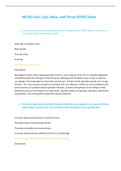Exam (elaborations)
NR 661 Ears, Eyes, Nose, and Throat (EENT) Exam (GRADED A+) Questions and Answer elaborations | 100% Guaranteed Pass
- Course
- Institution
NR 661 Ears, Eyes, Nose, and Throat (EENT) Exam 1. A 30 year old male has been diagnosed with non-allergic rhinitis. What finding is more likely in non-allergic rhinitis than allergic rhinitis? Older age of symptom onset Male gender Post nasal drip Sneezing Older age of symptom onset Explanation: N...
[Show more]



